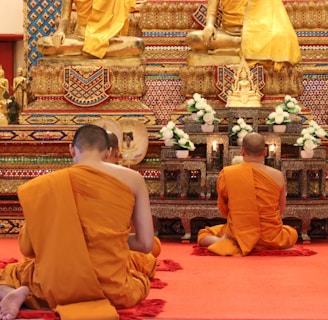The History of Thai Massage: Ancient Healing for the Modern Wellness Traveller
Uncover the history of Thai massage, from its ancient Buddhist and Ayurvedic roots to its place in modern wellness tourism. A must-read for curious travellers seeking deeper healing experiences.
4 min read


The Story Behind Thai Massage: A Journey Through Time and Touch
How far would you travel for a good massage? If it’s a Thai massage, some people fly halfway around the world. Sure, the rhythmic pressure and assisted stretches feel grounding yet energising. But what makes a Thai massage truly special for wellness travellers is the deeper story it tells. Behind every palm press and every stretch is an ancient healing practice shaped by faith and culture.
Rooted in a blend of Indian Ayurvedic medicine and early Buddhist philosophy, Thai massage dates back over 2,500 years. It’s said to have been developed by Dr. Jivaka Kumar Bhaccha, a legendary physician who cared for the Buddha himself. Over centuries, this healing art spread through monasteries and temples across Southeast Asia, becoming both a spiritual and physical practice.
In today’s serene spa settings or under shaded temple eaves, you’re stepping into a tradition that has touched lives for generations. Let’s dig into what makes Thai massage unique, some key moments in its historical evolution, and what it looks like today.


Healing Traditions from Temple to Mat
What sets Thai massage apart is its seamless blend of bodywork and mindfulness. It’s about muscle tension, yes, but so much more: energy, breath, and intention. Traditionally practised by monks, the massage was an act of compassion rooted in the four divine states: loving-kindness, compassion, sympathetic joy, and equanimity. These poetic ideas guide every movement, every stretch. When you're lying on that mat receiving a treatment, you’re participating in a ritual that honours both giver and receiver.
Now that we’ve traced its spiritual foundation, let’s explore how Thai massage was carefully preserved through generations.


Ancient Knowledge Etched in Stone
Despite its spiritual strength, Thai massage faced a fragile history. Much of its knowledge was passed down orally, making it vulnerable to time, war, and power shifts. In the 1830s, King Rama III took a crucial step to preserve it by commissioning marble inscriptions at Wat Pho in Bangkok, a Buddhist temple complex and Thailand’s oldest public university of traditional medicine. Today, these carvings still teach, showing poses and pressure points that connect the modern traveller to centuries of wisdom. Overlooking the Chao Phraya River, Wat Pho preserves ancient medical texts and is a popular tourist site because of the famous Reclining Buddha, the massive gold-leaf covered statue.
Now that we’ve seen how the principles underpinning Thai massage was carved into stone, let’s look at how the practise expanded beyond Thailand’s borders to reach a global wellness audience.


Thai Massage’s Global Embrace
As wellness tourism grew, Thai massage—also known as Nuad Thai—followed. Its rise was helped along by yoga’s global popularity, the spa boom of the early 2000s, and increasing interest in holistic healing. By 2019, Nuad Thai earned UNESCO status as Intangible Cultural Heritage, a global nod to its cultural and spiritual depth. Whether you're in a luxury wellness resort or a tucked-away retreat in northern Thailand’s Chiang Rai, there’s a sense of shared reverence for what this practice represents.
Now that we understand how Thai massage earned global recognition, let’s talk about how you can experience it with purpose and authenticity today.


Experiencing Thai Massage as a Wellness Traveller
From lantern-lit temples in mountainous Chiang Mai to serene spa villas on the island of Koh Phangan, your Thai massage experience can be as traditional or contemporary as you like. Some centres offer 90-minute sessions in silence, where mindfulness is part of the method. Others fuse Thai techniques with aromatherapy or herbal compresses. Regardless of setting, what unites them is the profound sense of wellbeing travellers feel—relaxed yet renewed, grounded yet open. And when you choose certified practitioners or visit respected training schools, like those in Bangkok or Chiang Mai, you’re supporting the cultural heart of Thai healing.
A Cultural Experience That Stays With You
There’s nothing quite like a Thai massage. Maybe it’s the way your body loosens while your mind quietens, or maybe it’s the realisation that you’re connected to something much older than yourself. More than physical therapy, it’s about cultural exchange, sacred tradition, and emotional connection. Travellers leave their sessions feeling relaxed, centred, and a little more in tune with the world.
No matter how far you have to travel, go get that Thailand massage. Immerse yourself in a living tradition that continues to heal across centuries and continents. As we like to say here at Wanderwell—you deserve it!
Want to read more? Thailand's Best Wellness Retreats for a Rejuvenating Escape. Thailand's Newest Island Destinations in 2025: Hidden Gems for Your Next Beach Escape. A Day in the Life of a Guest at a Luxury Ayurveda Retreat: The Ultimate Wellness Experience. Yoga in Bali - Why the Island is a spiritual Powerhouse.

